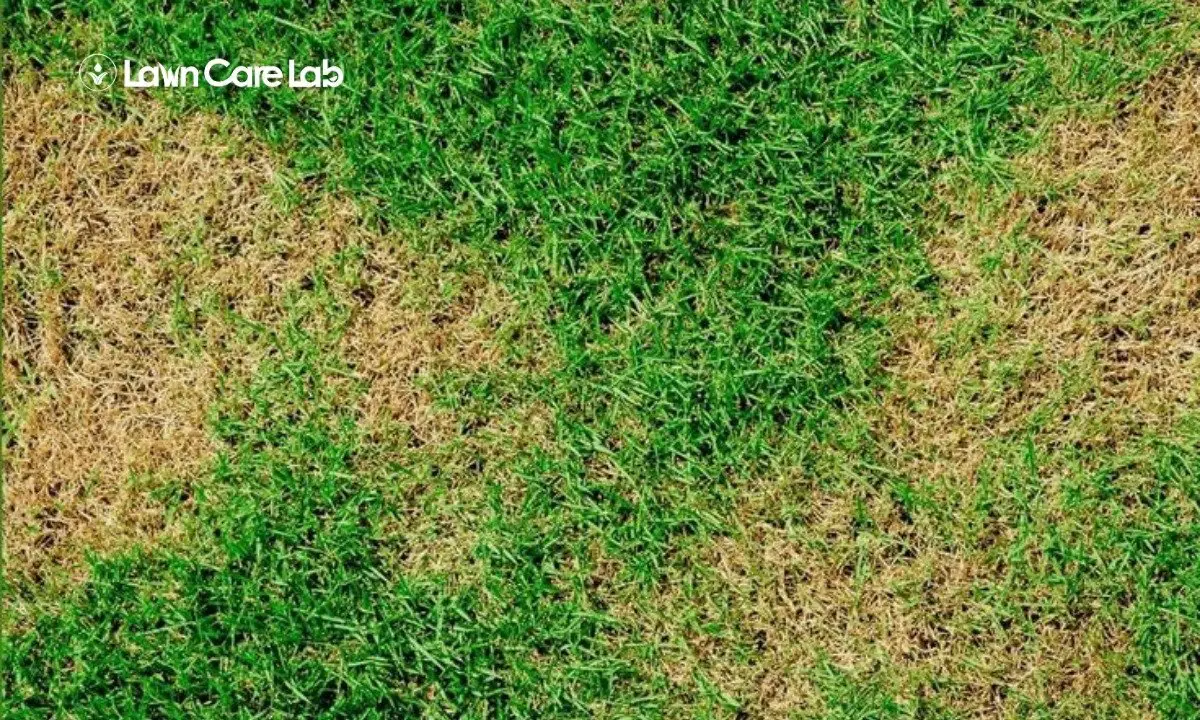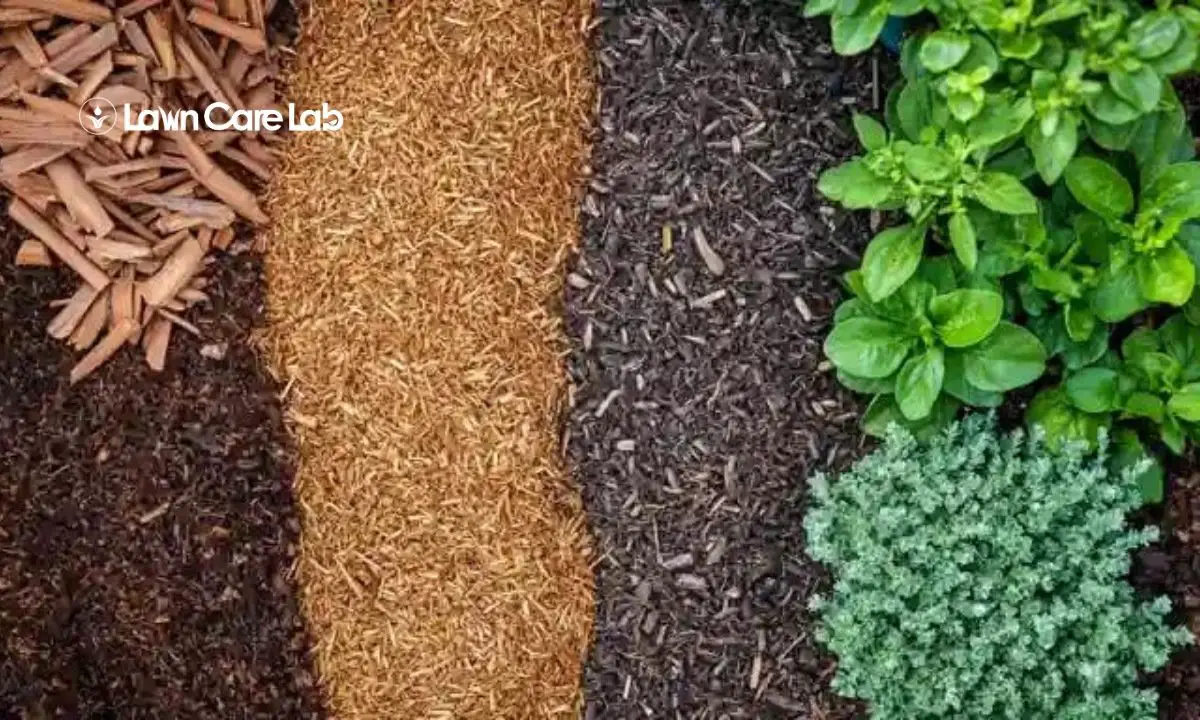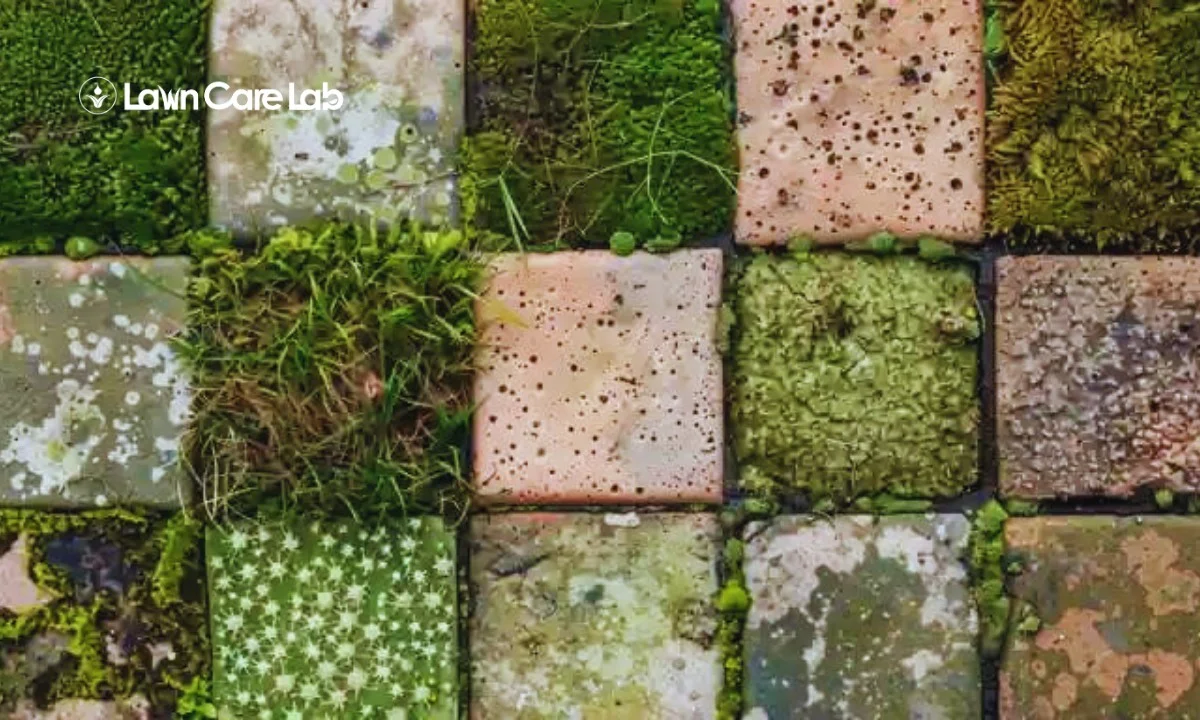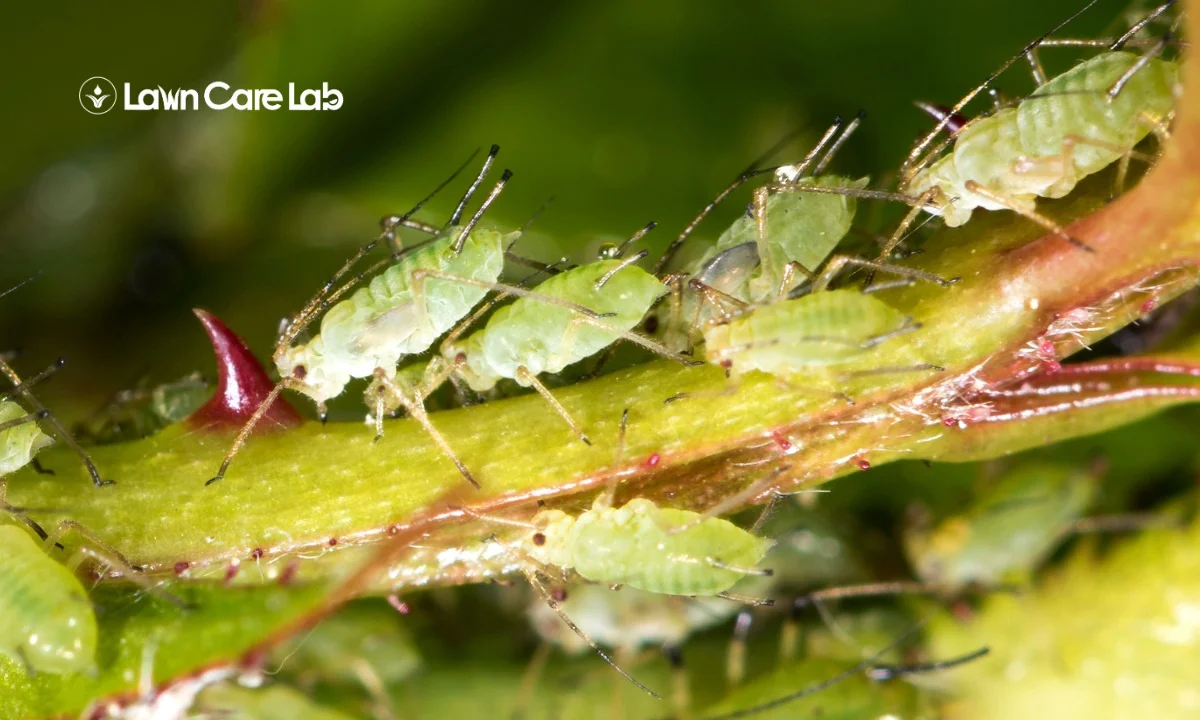Facing a mysterious adversary that’s turning your verdant lawn into a reddish-brown desert? That’s lawn rust, and it’s a genuine menace to your outdoor haven. Fear not, you’ve come to the right spot. We’re here with the tools and tactics you need to tackle this issue.
Let’s equip you with the right know-how and practical advice to halt lawn rust in its path. With our help, your lawn can maintain its healthy, vibrant glow.
Table of Contents
How to Accurately Identify Lawn Rust Disease: Symptoms and Early Warnings
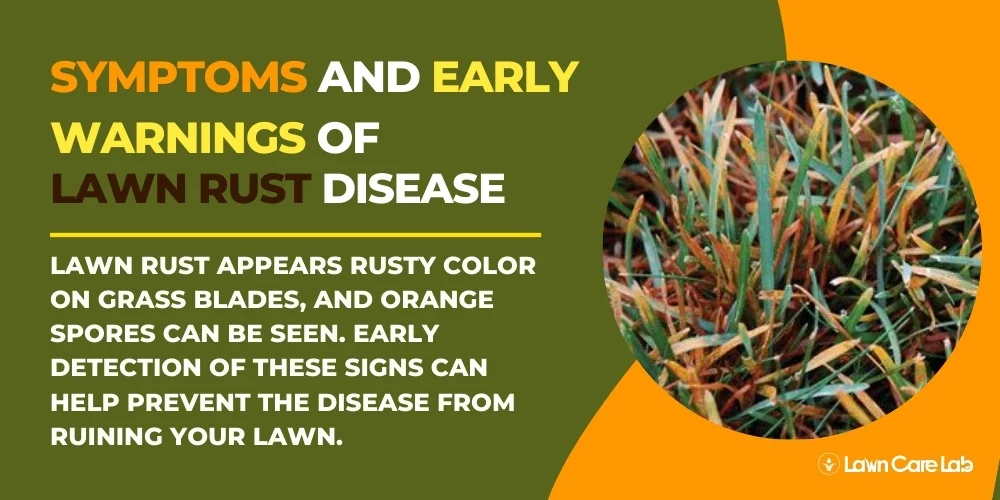
Identifying lawn rust involves more than just noticing brown spots. There are particular signs that you should be aware of.
Let’s discuss this lawn disease’s distinctive characteristics and the initial warning signs.
Clear Signs Your Lawn is Suffering from Rust Disease
Have you seen your grass turning a rusty reddish-brown lately? It could be lawn rust disease.
Lawn rust appears rusty color on grass blades, and orange spores can be seen. Early detection of these signs can help prevent the disease from ruining your lawn.
Understanding the High-Risk Seasons and Grass Types: When is Your Lawn Most Vulnerable?
Rust disease doesn’t affect your lawn all year round. Certain seasons and grass types are more susceptible. This can help with disease prevention.
The Most Susceptible Seasons for Lawn Rust Disease
Rust disease is more likely to affect your lawn during late summer and early fall due to high humidity and low light. Implement preventive measures such as appropriate fertilization and irrigation methods during these periods.
Certain grass types, including ryegrass, Kentucky bluegrass, and zoysia grass, are particularly prone to rust disease. Keep an eye out for early signs like yellowing grass and rusty spores to start treatment quickly.
With this information at your fingertips, you can efficiently prevent the onset of lawn rust.
Let’s now discuss more about the grass types that are more prone to this disease.
Types of Grass That are Prone to Rust Disease
Certain grass types are more susceptible to rust disease. Ryegrass is highly vulnerable in late Summer and early Fall, Bluegrass is moderately susceptible in mid-summer and early Fall, while Fescue and Bermuda Grass are less prone. Bermuda Grass has a very low risk all year round.
Recognizing symptoms like yellow-orange dust and thinning turf can help in early detection. While there are effective treatments, a better approach is choosing grass types resistant to the disease for a rust-free lawn.
Besides, adopting proactive lawn care practices like appropriate fertilization and watering can also aid in preventing rust disease.
Fertilization and Watering Techniques for Lawn Rust Prevention
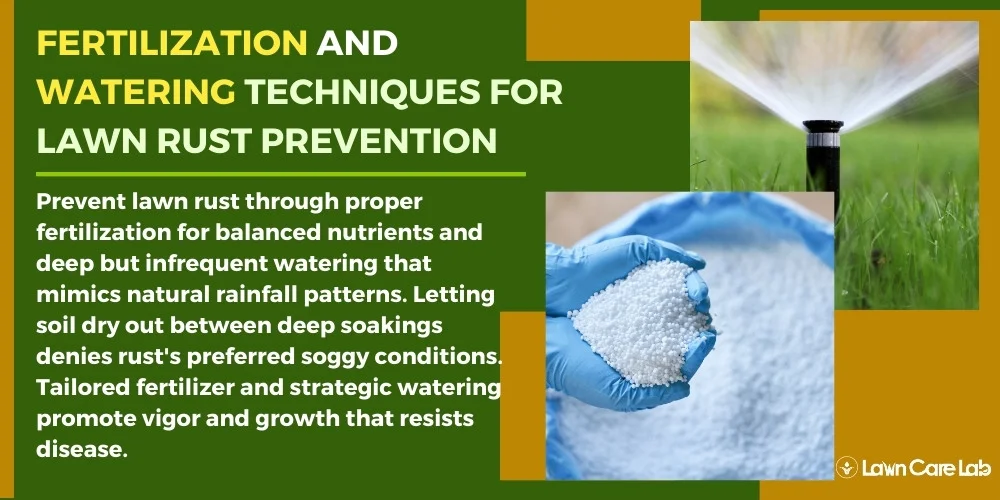
Taking action to avert lawn rust is crucial. Grasping and implementing appropriate fertilization and watering methods can be your primary protective shield.
Once these are under your belt, you’re stepping closer to maintaining a vibrant, rust-less lawn.
Mastering Fertilization to Ward Off Rust Disease
To combat rust disease, it’s important to hone your skills in fertilization and watering. These techniques can significantly improve soil quality, bolster disease resistance, and avoid nutrient shortages.
Here’s how to do it:
Consistently applying fertilizer at the correct times and quantities will ensure your lawn is well-nourished. Providing a balanced mix of nitrogen, phosphorus, and potassium will enable your lawn to flourish.
Regular upkeep like mowing, raking, and aerating helps maintain a healthy lawn and deters rust disease.
When it comes to watering, it’s better to water deeply but not often, giving the soil time to dry out in between.
Proper Watering Techniques for a Rust-Free Lawn
Following up on your great work with fertilization and nailing your watering tactics is another essential part of preventing rust disease.
It’s all about balancing the soil’s moisture levels. A soggy lawn is a playground for rust, while a parched one is an open invitation to disease. Try to mimic Mother Nature’s rainfall rhythm by watering deeply but not often and letting the lawn dry out in between.
A savvy drainage system will stop water from gathering and inviting rust. It’s not just the water quantity that matters, but also the timing and method.
With smart watering, your lawn can stay lush, lively, and free from rust.
Your Go-To Strategies for Controlling an Existing Lawn Rust Disease Outbreak
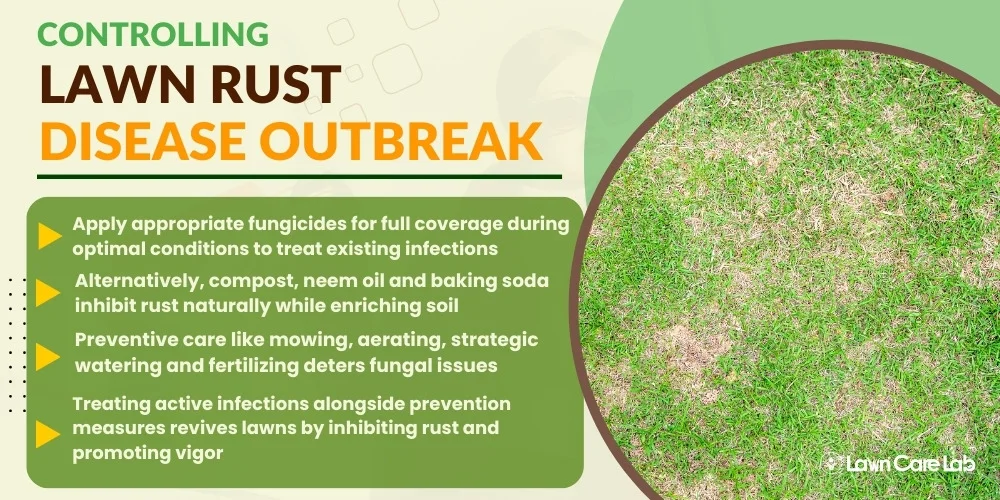
If you’ve noticed rust disease taking over your lawn, there’s no need to fret. The key is to get acquainted with effective fungicides and investigate some organic alternatives.
When used right, these strategies can halt the rust’s progress and rejuvenate your yard.
Fungicides That Actually Work: A Detailed Guide
Dealing with lawn rust can seem daunting, but the right fungicide can be a game-changer.
Here’s a brief rundown:
First, ensure your fungicide covers the infected spots, ideally applied in the morning for maximum effectiveness.
Second, remember that not all fungicides are created equal, so it’s worth doing some homework or reaching out to a professional for advice.
Third, pair your fungicide use with regular lawn care tasks such as mowing and aeration for ongoing prevention.
Lastly, safety first – adhere to the instructions on the label, wear proper protective gear, and avoid spraying when it’s windy to minimize drift.
Innovation isn’t just about new products but also smart, efficient use of existing resources.
Natural and Organic Solutions for Controlling Lawn Rust
Use eco-friendly options to manage lawn rust issues instead of relying on chemical fungicides.
Consider these three organic treatments:
- Composting enriches the soil and prevents disease if regularly applied to your lawn.
- When sprayed on affected areas, neem oil is a natural fungicide that enhances your lawn’s health.
- A baking soda solution that changes the pH and inhibits rust growth when applied to infected areas.
These methods not only manage diseases but also promote the overall health of your lawn. It’s important to remember that prevention is often the best solution.
Try these alternatives for a lusher, healthier lawn.
A Quick Recap of Your Lawn Rust Battle Plan
In conclusion, it’s crucial to remember that preventing and managing lawn rust disease revolves around prompt and proactive lawn care.
Therefore, always use these tactics to maintain your lawn’s optimal health.
In your crusade against lawn rust disease, you’ll need to focus on early identification, spread prevention, and potential treatment.
Keep an eye out for tell-tale signs like yellowing grass and orange spores – the sooner you spot these, the better.
Once you’ve identified a problem, it’s all about prevention. Regular mowing and watering will help your lawn stay healthy and resistant.
If an infection does occur, don’t panic – a carefully applied fungicide can do wonders. For those who prefer a more natural approach, consider options like compost tea.
But remember, maintaining a rust-free lawn is a continual process, not a one-off task.
Armed with this knowledge, you’re ready to halt lawn rust in its stride.
Final Thoughts: The Importance of Consistent Lawn Care for Avoiding Rust
Consistent lawn care isn’t just for looks; it’s vital in stopping rust before it starts. The perks of frequent, long-term attention to your lawn are obvious – it helps maintain the health of your greens. The weight of preventative steps is massive.
Here’s a simple chart that shows what happens when you stick to regular lawn care:
| Regular Care? | Lawn Health | Rust Outbreaks | Costs | Curb Appeal |
|---|---|---|---|---|
| Yes | Good | Few | Low | High |
| No | Poor | Many | High | Low |
To keep your lawn healthy, apply efficient methods, commit to regular maintenance, and be proactive in preventing issues like rust. Consistent care is key.
Frequently Asked Questions
What Are Some Common Misconceptions About Lawn Rust Disease?
How Does Lawn Rust Disease Affect the Overall Health and Growth of Grass?
Are There Any Natural Remedies or Household Items That Can Be Used to Treat Lawn Rust Disease?
Can Lawn Rust Disease Spread to Other Plants or Affect Pets and Humans?
How Long Does It Typically Take to Eradicate Lawn Rust Once Treatment Begins Fully?
- How to Create a Lawn Care Schedule for Southern Climates - October 30, 2024
- How to Use Compost Tea to Boost Lawn Growth and Soil Health - October 23, 2024
- The Best Grasses for Saltwater-Exposed Lawns: Coastal Lawn Care - October 17, 2024

